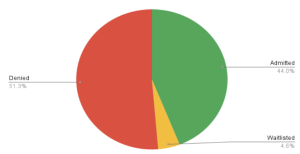29 Steinmetz Symposium celebrates students and science
May 16, 2019
The 29 Annual Steinmetz Symposium marked an important scientific milestone for many students and advisors, and their families. Some students gave their first scientific talk, or stood proudly beside a research poster for the first time. Others were marking the end of their college careers as they progress into jobs, gap-years and graduate schools.
As students and visitors crowded into classrooms and squeezed through the poster session they were celebrating the accomplishments of individual student-researchers, as well as acknowledging the important role of academic engagement on campus. Around 400 students presented, with many of them working on scientific and engineering-related projects.
Oral presentations ranged in topic from Computer Science, to Physics and Astronomy, to Sustainable Materials, to Exercise and Its Effects. Vanessa Raskin ’19, who presented her senior thesis work in the Developmental Biology session, commented that, “The presentations are an opportunity to show that you know your stuff, and demonstrate how much you’ve learned.” Presentations were open to all. Presenters needed to keep experts engaged, while explaining their work to younger students and visitors. Raskin explained, “You learn and understand your project the best when you teach it and take the material to a common level.”
Each 15 minute presentation concluded with approximately five minutes for audience questions. Faculty and young students alike were encouraged to delve deeper into the topics presented through their inquiries. Afterall, Charles Steinmetz once said, “There are no foolish questions and no [person] becomes a fool until [they have] stopped asking questions.”
Many students in the audience were there to support their friends and learn more about research projects that might only have heard of during a hurried explanation over dinner or during a walk to class. Damarys Merida ’19 explained that, “As a senior I’m excited to see people so happy to present and to watch them be so passionate about their projects.” Student’s investment in their projects was evident in their results, and in the quality of the presentations themselves. Many students had to watch the clock to ensure their enthusiasm didn’t overextend their talk.
Abstracts for each project were available on the Steinmetz website and gave a brief summary of the work that students had already accomplished. For example, Yifei Zhu ’20 determined that carbon nanotubes can be chemically modified to improve their solubility and conductivity for use in electrical applications. He was also recognized on prize day with the Charles B. Hurd Prize for outstanding work in physical chemistry. Lisa Gu ’19 presented on her efforts to create an automatic irrigation system for the greenhouses of the Schenectady ARC and was later recognized with several awards, including the “Daniel F. Pullman Engineering Prize.”
In a session just as important as the oral presentations, many students participated in the poster sessions held in Schaffer Library and Wold Atrium. These spaces were packed as presenters gave their “schpeels” on topics such as “The Union College Catalytic Aerogel Testbed”, “Forces Between Inclusions on a Lipid Bilayer”, and a “Twist Assist Bottle and Jar Opener”. Some students and groups even brought their final engineering projects with them, and demonstrated the abilities of their devices to the audience.
Merida captured the event well, saying “My friends have achieved so much and I’m so proud of them. I’m really glad this day exists”. Sandwiched between SpringFest and Alumni Weekends, the Steinmetz Symposium served as an important reminder that students can, and should, take pride in their academic achievements.




